It’s ‘Fowl Friday’ again, and we have good news, and some bad news. So we can head into the weekend on a brighter note, we’re going to start with the bad news.
‘Roo’…
Our favorite hen, ‘Roo’, died Thursday morning.
She got the name ‘Roo’ because as a young pullet, the size of her comb and wattles, and her overall tall and lanky appearance wasn’t quite right for a Buff Orpington hen. Her shape was more like a Leghorn, and we were certain she was going to be a rooster. She even developed a spur on her right leg. The name ‘Roo’ stuck. Even though she turned out to be one of our best laying hens, she never lost her rooster-like looks.
Wednesday night we found ‘Roo’ underneath the coop, looking very down and dumpy. She suddenly didn’t look like her usual chipper self. Her tall comb had become very pale, and was slumped over her forehead, her eyes were half closed, and she didn’t even muster the energy to give me her customary pecking when I got too close. We brought her into the house, set her on a heating pad, and re-hydrated her, but she declined very rapidly, and died early Thursday morning.
I’ll spare you all the details, and the photographs, but when a hen dies here at the farm, they are necropsied to ensure that the cause of death is not a potential flock health problem. Even though for us our hens are pets, it’s necessary and important when the health of the entire flock may be in jeopardy. The preliminary necropsy showed she was a remarkably healthy hen, except for a severely, and fatally impacted oviduct.
‘Roo’ had a history of reproductive trouble before. Her eggs had always been ‘different’. There was always a moderate-sized shell defect over the air-cell end of her eggs, so a ‘Roo’ egg was always easy to spot in the nest box. Her eggs had been like that since she first came into lay around 5-6 months of age.
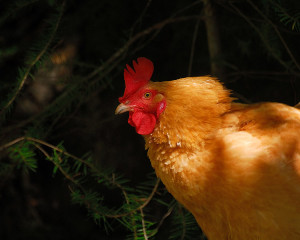
Roo would get a little ruffled every time we asked her to 'coop up' after ranging around the gardens
Then, almost two months ago, she had a single episode of egg-binding. She had been laying like clockwork, every few days, but in March she formed an egg that was larger than normal for her, and it had become stuck in her oviduct. We caught the problem early because it was obvious she was straining to pass her egg. She was removed from the flock, and treated with multiple warm-water baths, kept warm under heat lamps, and given supplemental nutrients including calcium to help her pass the egg. She loved her baths…and would often fall asleep in the warm water (with me holding her head up of course). If you’ve never seen a chicken taking a bath, well, here’s ‘Roo’ enjoying a nice warm soak…
Perhaps our next coop needs a hot-tub?
‘Roo’ did eventually pass her egg, almost 5 days later, which is unusual…not that she passed it, but that it took 5 days! We were relieved, as I’m sure she was too. The causes of egg binding are numerous, but without surgery, egg binding is frequently and rapidly fatal in hens, especially if the egg hasn’t passed within 48 hours. She was a very lucky hen, and after she recovered, she returned to the coop, and normal daily life here at the farm…with the caveat that a hen that survives egg-binding may be prone to recurrent reproductive problems.
Unfortunately, as happens in some cases, Roo’s oviduct function never returned to normal, and a dense aggregate of malformed egg material apparently began to accumulate, eventually leading to her fatal obstruction Thursday morning. There was little to suggest that she had a problem, until she collapsed beneath the coop Wednesday night. She hadn’t laid any more eggs since her egg binding episode, but this is not unexpected after the stress of egg-binding, as hens will go ‘offline’ for a while. Otherwise she’d been eating normally, running around catching bugs, weeding, and dust bathing with the rest of the girls right up until Wednesday morning.
We’ll really miss ‘Roo’ around our gardens, always on alert, watching for hawks, always the first to squawk when a deer or bobcat wandered through the yard. The farm has been noticeably quieter without her today.
…and the Ark
Aside from chicken catastrophes, in between various planting and weeding chores this week, we’ve been constructing a new, portable, chicken coop for the gardens.
This time we’re building an ark-style coop. This ark can house 6-8 hens comfortably, and was constructed to be the perfect size to fit over one of our fallow raised garden beds.
At night the hens will be secure in the enclosed upstairs roosting area, and during the day can either be in the secure run below, or out wandering freely while we’re out working in the gardens. With the garden area now fenced, they’ll have a wide area to weed and bug hunt in.
The upstairs will also house a nest box, but as our ladies aren’t laying as frequently, nest boxes weren’t the priority in this design, compared with the coop we built previously. Their only job now is to keep the garden bugs in check, and help with pulling weeds…occasional eggs are just a bonus. We’re still adding some finishing touches, but the ark should be complete tomorrow.

Hens are funny...acres of property, and they always want the same bug, in the same square inch of soil as the other hen
Obviously the new coop construction is because our ever-growing chicks are getting anxious to move to larger accommodations. This weekend we’ll be moving the older hens out to their new abode, although sadly now ‘Roo’ will not be joining them. The run on the old coop will be expanded in the coming weeks to accommodate the new chicks, and an extra bank of nest boxes will also be installed, although the new girls won’t need those until around mid-September.
Once the older hens are moved, we’ll clean out the large coop, and move our young chicks outside, well, most of them…we’re still undecided on the ‘mystery chick’ who still isn’t fully feathered, so we may hold a few chicks in the brooder box for a few more days so ‘Frodo’ isn’t alone.
We’ll update everyone on this weekend’s ‘moving day’ activities in our next, and hopefully much cheerier, Fowl Friday post.
We’ll leave you with a happy ‘Roo’, having fun in the garden…you can’t miss her, she’s the one with the tall comb and long wattles in the back.

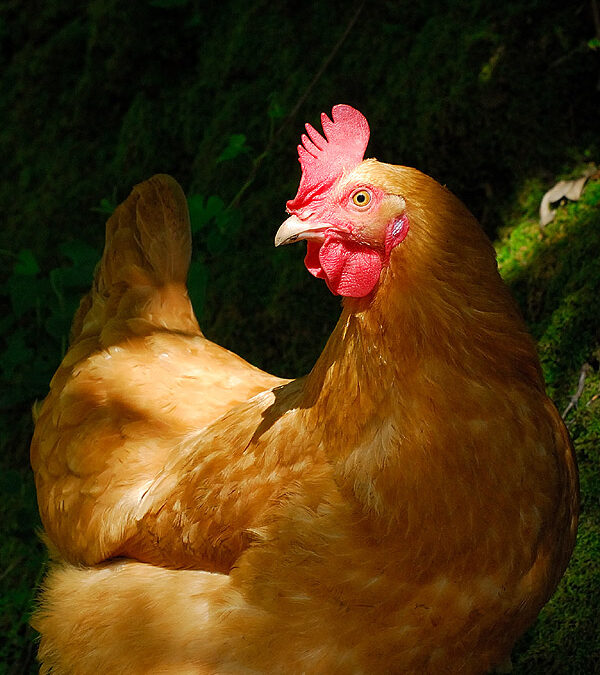
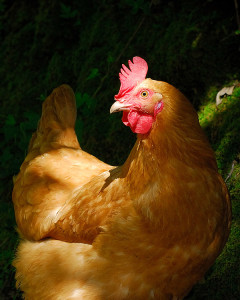
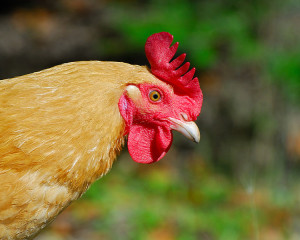

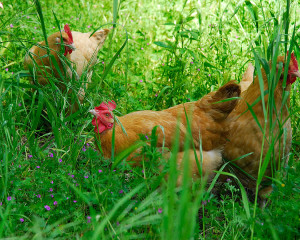
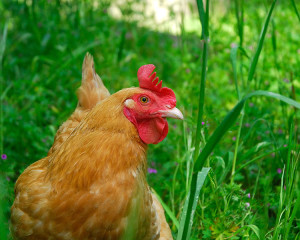
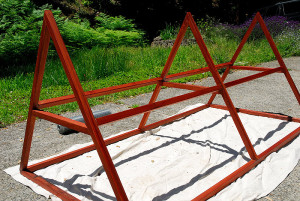
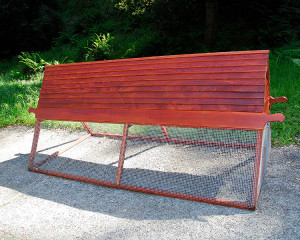
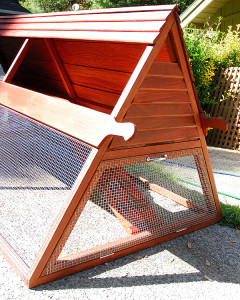
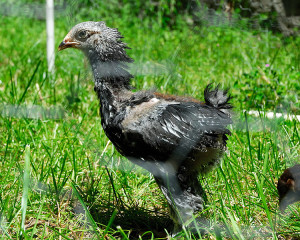







Your favorite picture of ‘Roo’ is my almost favorite of all your beautiful farm pix! She was a striking standout …sorry for your loss.
Oh, I am totally charmed by the hen butts picture too!
I’m so sorry to hear about Roo. She was gorgeous BTW. We’ve lost a few birds ourselves, including one of my favorites, so I can understand how upsetting it can be. It amazes me how fast they can go down too.
.-= Dog Island Farm´s last blog ..Friday’s Gardening Tips – Watering – Hand watering vs. Irrigation =-.
I love the photo of Roo in the bath. Do you think Roo’s unusual appearance and her reproductive problems were related? Makes me wonder if there was some kind of chicken intersexuality going on here. The division between male and female isn’t always as neat as we humans like to pretend it is.
.-= Jean´s last blog ..Weed, Water, Mulch: A Low-Maintenance Perennial Garden Strategy =-.
You’re right Jean, and we’ve wondered the same thing. I’ve seen some chickens that are clearly half rooster half hen (where the feather pattern is the give-away). Some chickens will have both gonads present, so it’s obvious, at least on necropsy. Roo only had an ovary at necropsy. There is a milder inter-sex condition in chickens, where hens will have tissue within the ovary that, at least microscopically, resembles testicular tissue. I really wonder if that may have been going on with her. Her comb and wattles were out of the norm for an Orpington hen, but the spur was even more so. She layed more eggs than our other Orps too. I do have to think that hormonally things may have been in disarray from the beginning. After she egg-bound, she continued to produce yolk material, even though she wasn’t actively laying. Funny ol’ Roo…I suppose we’ll never really know for certain.
Oh, that’s so sad. You are my heroes for doing necropsies. That takes a lot of grit.
One of my sister’s hens got egg bound, and it was weirdly comical to follow her efforts to find a chicken expert who could do a proper exam in Brooklyn NY.
.-= lisa´s last blog ..…and the Nominees are… =-.
Oh my! A chicken in Brooklyn? That definitely qualifies as an urban chicken! I think a lot of vets who didn’t train in poultry, are finding themselves having to learn about poultry these days…chickens aren’t as common in the household as dogs and cats, but they have become very popular, even in the city!
I am very sad to hear about Roo. No hen could have had such loving care. Your videos are wonderful fun! She was quite an unusual looker! Five weeks to pass an egg!!! Your new coop is great! How large is that? Great idea to be able to be portable!
.-= Carol´s last blog ..Walking South Into Upper and Middle May Gardens. =-.
The portable coop is a 4-foot equilateral triangle, that’s 8 feet in length. The 8-foot x 4-foot footprint (that’s a lot of feet) is the same dimension as our raised beds in the garden. We should have a photo of it set up over a raised box in next week’s post. The box will serve as a ‘foundation’ of sorts. Although this coop isn’t huge, they will have the run of the fenced-in gardens now, so they’ll get lots of exercise, and hopefully the coop will be as secure as our old one.
I am sorry to hear about Roo and I’m sure she will be missed. I enjoyed looking at all of your great photos!
.-= Amy/GoAway, I’m Gardening!´s last blog ..What Is Your Gardening Style? =-.
Sorry to hear about Roo, she sure sounds like she was a special chicken. She did look cute in her bath.
Your new ark looks really great, those chickens have a nice retirement home to move into 🙂
.-= Catherine´s last blog ..New surprises – Fertilizer Friday. =-.
Oh what a terrible few days you had Clare – Roo certainly was one of the family and ever so cute. I had thought the same thing as Jean when I was reading through the article.
As I am only learning about chickens what are necropsies?
.-= Rosie@leavesnbloom´s last blog ..Brides Blossom and Petal carpets =-.
Rosie, by convention a necropsy is the term we use for a postmortem on animals. The term autopsy is most correctly applied to a postmortem of a human, by a human. Auto meaning self, or applied to self or likeness of self.
I’m very sorry to hear about Roo, but glad she didn’t die of something contagious.
Glad all the little ones are coming along nicely, and can’t believe the mystery chick ;-> They know how to keep you in suspense, don’t they?
Sorry to hear about Roo. it was a very interesting article. I learned a lot about chickens. Sounds like they have a terrific home with you as well. My only memories of raising chickens on a farm werent good ones. We had a mean ol rooster that would chase us everytime we stepped out of the house.
.-= Tammy´s last blog ..Iris Blooms =-.
Oh, I am sorry to hear about Roo. She sounds like a memorable character. I am glad that she did not have a problem that could have affected the rest of the flock. I cannot wait to see what Frodo will look like when he is grown. I wonder if he will have feathers by then?
.-= Noelle / azplantlady´s last blog ..Very, Vibrant Vinca… =-.
A chicken taking a warm bath is hard to swallow. But seeing is believing.
.-= wiseace´s last blog ..Woodland Wildflowers =-.
Roo was a good-looking gal and I am very sorry that you have lost her.
.-= Daffodil Planter´s last blog ..Episode 2: Love blooms in Asheville, North Carolina =-.
Sorry to hear about Roo. At least you have a whole new flock to busy yourself with. I wonder if some breeds have more personality than others. When my roommate had 5 chickens, 3 of the same breed and the other two a different breed each, the 3 were pretty non-descript, but another, a red hen, had tons of personality. Not all of it good. She was quite bossy.
.-= Brad´s last blog ..UC Berkeley California Native Bee Garden =-.
Dear Roo. My condolences, Clare, but at least you have some great memories. I had the same thought as Jean while reading, that the spur and comb were maybe hints that all was not as it should be in the reproductive arena — and yet, it worked to make her particularly beautiful and especially productive, at least for a time.
Hoping next week’s Fowl Friday finds you with better news!
.-= Meredith´s last blog ..a hint of joys to come =-.
Poor poor Roo. How very sad.A beautifully written and informative post. I love the little video clips, especially of all the chickens set to Jazz. I was very moved by this post and your obvious devotion to all your animals.
I’m so sorry to hear about Roo but also relieved to know she was one of the lucky ones that got to live at Curbstone and truly be cared for and appreciated. It’s obvious she was special from the very beginning.